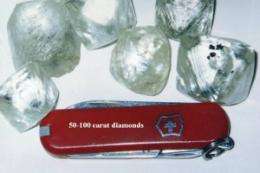Geologists explore clues to Earth's formation in diamonds

(�鶹��ԺOrg.com) -- When jewelers inspect diamonds, they look for cut, clarity, color, and carat. When University of Tennessee, Knoxville, geologists Larry Taylor and Yang Liu inspect diamonds, they look for minerals, inclusions jewelers hate, but whose presence could be clues for how parts of earth formed.
Taylor, distinguished professor of earth and planetary sciences, and Liu, research assistant professor, have been awarded $380,000 by the National Science Foundation. The UT geologists will partner with researchers from the Russian Academy of Sciences to study diamond deposits in northern Siberia.
Diamonds in that region are veritable time capsules, giving researchers a window into how the continent of North Asia formed.
“These diamonds are carrying information that goes back 3.5 billion years,” said Yang. “It helps us piece together how the deep mantle beneath the Asian continent formed and how it evolved.”
These diamond deposits are some of largest in the world. They are also some of the most well-preserved, thanks to the cold climate, which protects against weathering by encasing the diamonds in permafrost. Also, Siberia contains thousands of unique volcanoes, called kimberlites, that carry diamonds to the surface from hundreds of miles deep within the earth, unlike ‘normal’ volcanoes which carry them from a few miles deep.
“The diamonds are brought up through a conduit called a pipe by this strange volcanic magma called a kimberlite,” Taylor said. “These kimberlites are the sources of the major diamonds of the world and are the carriers of these prizes from the mantle, where they have formed in high-pressure and high-temperature environments.”
The researchers’ goal is to determine how Asia’s craton—the part of a continent that is stable and forms the central mass of the continent—formed and built upon itself over billions of years. By examining the chemical isotopes of the minerals inside the diamonds, the researchers are able to date the minerals and diamonds and trace their evolutionary history.
“In order to obtain the important chemical information, we polish the diamonds and expose the mineral inclusions,” Yang said. “There are no natural materials harder than diamonds, so they are very difficult to polish. We are the only group in the United States that polishes diamonds for scientific purposes.”
Through this project, the scientists have access to samples from across the Siberian craton that will enable them to reconstruct the complete life of the craton’s early formation, which eventually led to the consolidation of the Asian continent.
The three-year collaboration between UT and the Russian Academy of Sciences was established with a formal agreement for an exchange of scholars. The agreement was signed by Taylor and academician Nikolai Pokhilenko in Novosibirsk, Siberia, this August.
Provided by University of Tennessee, Knoxville




















